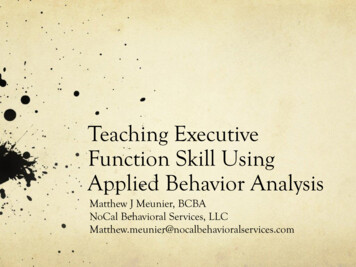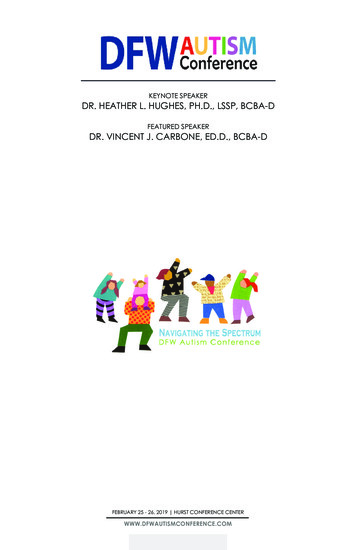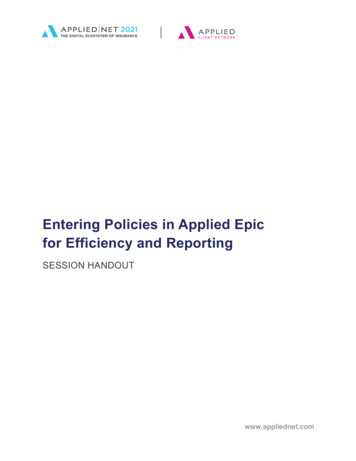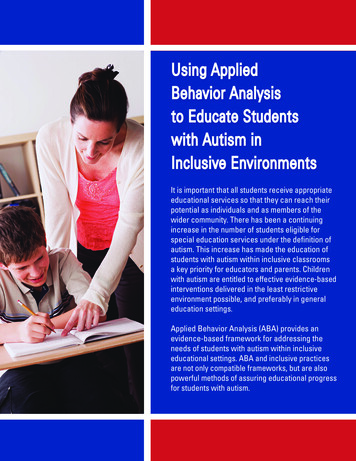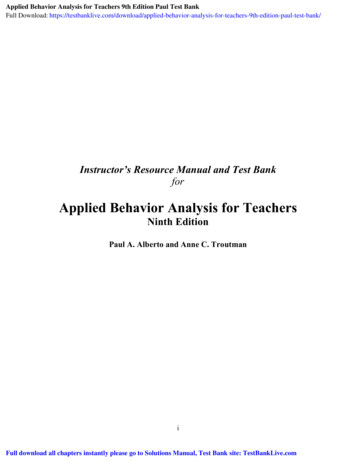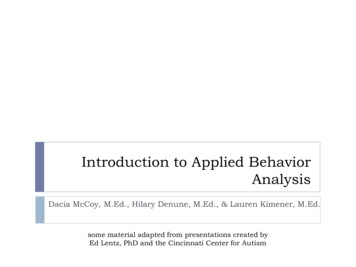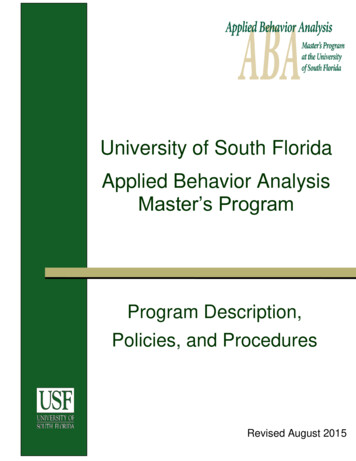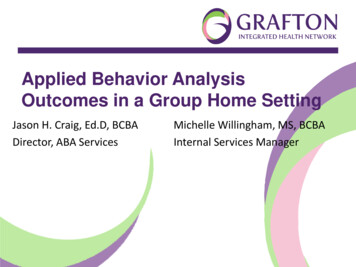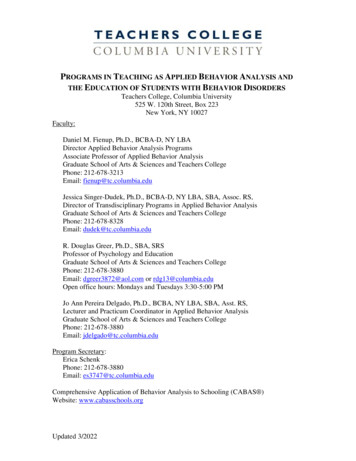
Transcription
PROGRAMS IN TEACHING AS APPLIED BEHAVIOR ANALYSIS ANDTHE EDUCATION OF STUDENTS WITH BEHAVIOR DISORDERSTeachers College, Columbia University525 W. 120th Street, Box 223New York, NY 10027Faculty:Daniel M. Fienup, Ph.D., BCBA-D, NY LBADirector Applied Behavior Analysis ProgramsAssociate Professor of Applied Behavior AnalysisGraduate School of Arts & Sciences and Teachers CollegePhone: 212-678-3213Email: fienup@tc.columbia.eduJessica Singer-Dudek, Ph.D., BCBA-D, NY LBA, SBA, Assoc. RS,Director of Transdisciplinary Programs in Applied Behavior AnalysisGraduate School of Arts & Sciences and Teachers CollegePhone: 212-678-8328Email: dudek@tc.columbia.eduR. Douglas Greer, Ph.D., SBA, SRSProfessor of Psychology and EducationGraduate School of Arts & Sciences and Teachers CollegePhone: 212-678-3880Email: dgreer3872@aol.com or rdg13@columbia.eduOpen office hours: Mondays and Tuesdays 3:30-5:00 PMJo Ann Pereira Delgado, Ph.D., BCBA, NY LBA, SBA, Asst. RS,Lecturer and Practicum Coordinator in Applied Behavior AnalysisGraduate School of Arts & Sciences and Teachers CollegePhone: 212-678-3880Email: jdelgado@tc.columbia.eduProgram Secretary:Erica SchenkPhone: 212-678-3880Email: es3747@tc.columbia.eduComprehensive Application of Behavior Analysis to Schooling (CABAS )Website: www.cabasschools.orgUpdated 3/2022
Teaching as Behavior Analysis 2GENERAL DESCRIPTION OF THE MASTERS OF ARTS INTEACHING AS APPLIED BEHAVIOR ANALYSIS:A STRATEGIC SCIENCE OF TEACHING(New York State Dual Certification Birth through Grade 6)Description of the Program: What and How Teachers Are TrainedThe Master’s degree in Teaching as Applied Behavior Analysis program isaccredited by the Association for Behavior Analysis International Accreditation Board.Our program is recognized for its excellence in training teachers in usingscientific tools to bridge the educational gap and accelerate learning for all children(Greer, 2007). Our program is internationally recognized for training teachers,researchers, and leaders in early educational and language developmental interventionsfor children with autism spectrum disorders (ages 2-5) and effective inclusion practices.Our graduates are expert in identifying missing verbal developmental stages (Greer &Du, 2015; Greer & Keohane, 2007, 2009; Greer & Ross, 2008) and providinginterventions that result in children attaining developmental stages when they aremissing. Teaching as Applied Behavior Analysis is a strategic scientific educationalmodel in which all instruction used by teachers is based on scientific evidence. In thisapproach, teachers use scientific procedures in the process of fitting the appropriatescience-based practices to individual students’ learning and language developmentalneeds. The program prepares graduates to be dually certified in general and specialeducation from birth to Grade 6 in New York State and reciprocating states and alsoprepares students to sit for the exam leading to NYS licensure in ABA. Finally, studentswho successfully complete the MA core courses will satisfy the requirements to sit forthe Board Certified Behavior Analyst (BCBA) exam. Students accepted into the programare placed in teacher assistant positions in model schools and classrooms that practiceteaching as applied behavior analysis (1 The training of teachers is also based onscientifically tested procedures. Teacher trainees are taught until they master the scienceand its application with children with and without disabilities from 1.4 years through fifthgrade.Content of Courses and the Application of the ContentAll of the training is done in classrooms that practice the CABAS and theCABAS Accelerated Independent Learner Model (AIL) (Greer, 2002, 2007). BCBAcertified teachers and behavior analyst supervisors who are experienced scientists andwho have achieved CABAS Board competency ranks supervise our MA students intheir school placements. Students attend classes in the evening and the content of the corecourses are directly related to the practices used in the school placements. The content ofthe 12 core graduate courses in include general applications of applied behavior analysis,basic science principles, epistemology underlying radical behaviorism includinginterbehaviorism, and advanced and specialized expertise in Teaching as AppliedBehavior Analysis. This specialized content consists of scientific findings for thePrograms in Applied Behavior AnalysisTeachers College, Columbia University Department of Health & Behavior Studies525 W. 120th Street, Box 223 New York, NY 10027
Teaching as Behavior Analysis 3management of behavior, teaching, curriculum design and procedures to identify andinduce missing levels of language and social development. The experience in the schoolsinvolves applications of the content of the core courses. Scientific procedures are alsoused to implement evidence-based tactics with all of the children in the schools. Theeffectiveness of the range of scientific tactics is well documented in the literature, as isthe effectiveness of the school model used in the settings where our students train. Recentevidence, concerning the outcomes for the children in the in the general educationclassrooms where our trainees are taught, shows that the children in one second-gradeclass performed from two to six grade levels above grade level on standardized testsacross reading, language, and mathematics. These children included those who receivedfree or reduced lunch (42% of the class), minority children (35% of the class), Englishlanguage learners (23%), children with autism spectrum diagnoses (23%), and uppermiddle class children (23%). Teachers and teacher assistants collect direct measures of allthe children’s responses to instruction and the achievement of state standards. The modelclassrooms where our MA and Ph.D. graduate students are trained include the Fred S.Keller Preschool (children with and without diagnoses from 16 months to age 5), as wellas the Morristown AIL general education classes Pre-K-5 and Rockland BOCESCABAS classes.The Type of Students We AcceptSuccessful applicants will present evidence of superior undergraduate academicperformance in liberal arts degrees, excellent writing skills, interest in using scientificprocedures to teach, strong recommendations, and a passion for accelerating the learningand development of children from economically disenfranchised communities, childrenwith native learning disabilities, and children from upper middle class students ininclusion settings. Students must submit GRE scores as part of their application. HoweverGRE scores are less important than undergraduate grades and evidence of interest in thesciences of behavior and learning as they can be applied to improving the educational andsocial prognosis of children. The program is academically rigorous and the appliedcomponent is demanding. Graduates of the program are highly sought after by publicschools and graduate programs. Between 15 and 25 applicants are matriculated annually.Typically there are 40 MA students and 25 Ph.D. students in the program.Research is a central component of the training—both the application of researchusing science-based tactics and measurement, and the generation of new research. Thefaculty and the students produce a substantial body of research publications and presentat international scientific conferences each year. Programmatic research is conducted inthe following areas: effective classroom practices, language/verbal developmentalinterventions that result in children learning to learn in different ways, observationallearning, and systems-wide scientific approaches to education. Publications by the facultyand students for the past 5 years are listed later in this document.The program requires excellent writing skills, a strong undergraduate record,interest in a science of schooling, and a passion for working with all children. Studentsare taught to use tested strategies to locate sources of learning and behavior problems andto select tested behavior analytic tactics and strategies that they in turn use to solve thelearning or behavior problem. In the MA program, students complete 10 to 15 replicationPrograms in Applied Behavior AnalysisTeachers College, Columbia University Department of Health & Behavior Studies525 W. 120th Street, Box 223 New York, NY 10027
Teaching as Behavior Analysis 4studies, complete with reports, master advanced behavior analysis texts, and learn toteach children using advanced behavior analytic repertoires until they achieve measurablyeffective competencies. MA graduates are in high demand for school positions, earlyintervention programs around the world, and Ph.D. programs in applied behavioranalysis. Graduates of the Ph.D. program are leaders in the field of applied behavioranalysis and evidence- based science of teaching and work in universities, direct schools,or do fulltime research. Over 200 students have achieved Ph.D.s in our program over thelast 47 years.Teaching as Applied Behavior Analysis Faculty and School SupervisorsFull-Time Faculty Program Director Professor R. Douglas Greer, Ph.D., CABAS Senior BehaviorAnalyst, Senior Research Scientist, Fellow of the Association for Behavior AnalysisInternational. Research in Verbal Behavior Development Theory, naming (i.e., howchildren learn language function incidentally), pre-verbal foundational behavioralcusps, generalized imitation, system components of effective schools, teachereducation, conditioned reinforcement Professor Jessica Singer-Dudek, Ph.D., Director of Transdisciplinary Programs inApplied Behavior Analysis, BCBA-D, LBA, CABAS Senior Behavior Analyst,Associate Research Scientist, CABAS Professional Advisory Board Member,CABAS Behavior Analyst Consultant. Research in rate of responding and effects onmaintenance and learning of more complex repertoires, conditioned reinforcement asa function of observation, acquisition of observational learning repertoires,foundational verbal development, system components of effective schools Daniel M. Fienup, Ph.D., BCBA-D, NY LBA. Research in behavior analyticinstructional design. Jo Ann Pereira Delgado, Ph.D., BCBA, NY LBA, CABAS Senior BehaviorAnalyst, Assistant Research Scientist, Research in sources for Generalized Imitation,procedures leading to an observational learning capability and verbal behaviordevelopment.Adjunct and Clinical Faculty Claire Cahill, Ph.D., BCBA-D, LBA, CABAS Associate Behavior Analyst,Assistant Research Scientist, Adjunct Assistant Professor. Research in naming,Verbal Behavior Development Jennifer Longano, Ph.D., BCBA-D, CABAS Senior Behavior Analyst, AssistantResearch Scientist, Assistant Director of the Fred S. Keller School, Adjunct AssistantProfessor. Research in conditioned reinforcement by observation, stimulus-stimuluspairing and emergence of naming, echoics and emergence of Naming, conditionedreinforcement for visual observation and accelerated learning Lin Du, Ph.D., BCBA-D, LBA, CABAS Senior Behavior Analyst, AssistantResearch Scientist, Adjunct Assistant Professor. Research in Generalized Imitation,Verbal Behavior Development Robin Nuzzolo, Ph.D., BCBA-D, CABAS Senior Behavior Analyst, AssistantResearch Scientist, Director of Fred S. Keller. Research in transformation of EOcontrol, tacts to replace palilalia, conditioned reinforcement and stereotypy, verballygoverned and observational learning by teachersPrograms in Applied Behavior AnalysisTeachers College, Columbia University Department of Health & Behavior Studies525 W. 120th Street, Box 223 New York, NY 10027
Teaching as Behavior Analysis 5 Jeanne Speckman, Ph.D., CABAS Senior Behavior Analyst, Assistant ResearchScientist, BCBA-D Associate Director of the Fred S. Keller School, AdjunctAssistant Professor. Research in naming, emergent suffixes, and joining of listenerand speaker capabilitiesCelestina Rivera-Valdes, EdM, CABAS Assistant Behavior Analyst, AssistantResearch Scientist, Assistant Director of the Fred S. Keller School. Research onVerbal Behavior Development and system components of effective schoolsRegina Spilotras, EdM, CABAS Associate Behavior Analyst, BCBA-D Supervisorof Rockland BOCES district-based CABAS classesJennifer Weber, CABAS Associate Behavior Analyst. Research in writing,observational learning, and Verbal Behavior DevelopmentSusan Buttigieg, Ph.D., BCBA-D, LBA, CABAS Associate Behavior Analyst.Research in naming, observational learning, and Verbal Behavior DevelopmentIf you are accepted into the program please e-mail Professor Dudek,dudek@tc.columbia.edu, so that she can begin arranging internship placementsfor you.Preparing Teachers and Teacher Trainers Who can Bridge the EducationalGap: A Comprehensive Science Based Teacher Training ProgramThe objective of our MA and Ph.D. programs is to prepare teachers and teacher trainersto use measurably effective instructional practices to accelerate all children’seducational progress, including measurable increases in enjoying learning and schooling,academic literacy, problem solving, and self-management. A key to doing this is theacceleration of children’s language development that appears to be the root problemfaced by English language learners, minority children from economically disenfranchisedfamilies, and children with autism spectrum diagnoses. Recent research findings provideexciting new ways to do this. Moreover, accelerated instruction is needed for childrenfrom well-to-do-families, if we are to assume international leadership in education. Inorder to meet these objectives we provide instructional experiences to teach our graduatestudent teacher trainees the following aspects of effective teaching: Master using research-based procedures for all aspects and subject areas ofteaching preschool and elementary age children (all types of aba measures,designs, IOA estimates, and all types of verbal behavior, verbal behaviordevelopment, and derived relations measures and designs). Manage classrooms and schools such that children are well behaved andmotivated to learn, using positive and non-coercive practices. Master the existing science of learning and teaching as it applied to the variedneeds of children (e.g., 200-plus tactics). Master protocols to identify and induce missing language developmental cuspsand capabilities that result in children learning to learn material they could notlearn before, and how to learn in new ways (e.g., by observation and incidentalexperiences). Master how to use key educational standards and how to match existing testedcurricula and tested teaching practices to categories of students and individualPrograms in Applied Behavior AnalysisTeachers College, Columbia University Department of Health & Behavior Studies525 W. 120th Street, Box 223 New York, NY 10027
Teaching as Behavior Analysis 6 students in order to ensure that the standards are achieved.Master how to continuously and directly measure all students’ progress inachieving standards and new developmental stages and use that measurement todrive instructional practice, including the selection of alternative scientificpractices when initial best practices are not successful with children.Master how to scientifically analyze the source of student learning problems andinadequate teaching.Learn to draw on evidence from cognitive learning and developmental research,reading/writing literacy research implemented through procedures from teachingas applied behavior analysis.Master how to teach children to be self-learners.Identify and design functional curricula building on the theory and science ofverbal behavior, radical behaviorism (as an extension of natural selection), thefoundations of pragmatism (i.e., Peirce, James, Dewey),All students accepted into the MA program are placed in full-time internships at ourCABAS Schools (see www.cabasschools.org), where they are mentored by those withmore expertise. These mentors are often students in the Ph.D. program in behavioranalysis. They train in the schools in the daytime and attend graduate classes in theevenings. Whenever possible, the internships provide salaries starting at around 22,000for beginning MA students, but no tuition benefits. The CABAS schools are run bybehavior analysts who hold advanced CABAS Board ranks and have research trackrecords. Thus, almost all of the students accepted into the program are funded. Allstudents must complete our MA courses and certification program. Even if a student isaccepted as a Ph.D. student, continuation in the Ph.D. program is contingent on his/herperformance in the MA program. This later requirement is necessary because the contentof our Ph.D. program requires the mastery of: (a) advanced applied behavior analysis, thespecialized expertise in teaching as applied behavior analysis, curricular design based onthe philosophy of contemporary behaviorism, and the verbal developmental protocolsdevelopmental research and practice. These combinations of repertoires are needed tosucceed in the Ph.D. program and mentor MA students. However, once the MA iscompleted, all prior MA courses with satisfactory grades will be credited towards thePh.D. If a student is dually certified in New York or eligible to be certified and holds aMasters degree he/she will need only to take the core MA requirements and do the MAteaching assistant experience/internship. Teachers College does not accept any transfercredits for MA programs.Teachers in CABAS schools and our graduate students receive ongoing, in-situtraining through three-tiered training modules leading to achievement of CABAS Professional Advisory Board competencies for the rank of Teacher I, II, or MasterTeacher. These modules incorporate content across all core courses and application inthe schools. The ranks act to synthesize expertise and have been reported in the researchliterature as strong predictors of student and client outcomes. MA teaching assistants inour schools complete the same rank requirements as Teachers, but in smaller increments.Completion of each teacher rank requires at least one calendar year of full time teachingin our CABAS schools. The Master Teacher rank may take longer to complete. Teacherranks consist of three components: 1) Verbal behavior about the science, which includesPrograms in Applied Behavior AnalysisTeachers College, Columbia University Department of Health & Behavior Studies525 W. 120th Street, Box 223 New York, NY 10027
Teaching as Behavior Analysis 7mastery of material presented in scientific texts or research/conceptual publications, 2)Contingency-shaped repertoires, which include teacher presentation of instruction andconsequation of student responding and management of classroom and behavioralcontingencies, and 3) Verbally meditated repertoires that involve analysis of student orclass-wide data and decision making, including implementation of tactics from theresearch literature of the science of applied behavior analysis. Teacher mentors who haveachieved the rank of Master Teacher may go on to complete Assistant, Associate, andSenior Behavior Analyst ranks, that include 5 components dedicated to: 1) Scholarshipexpansion, 2) Peer teaching and mentorship, 3) New research findings, 4) Direct orsystematic replications, 5) New conceptual contributions to the science or to theCABAS model. Those who publish research and conceptual papers and who present atnational and international conferences may also qualify for Assistant, Associate, andSenior Research Scientist (Ph.D. required) ranks. Only those whose names appear on thiswebsite have achieved ranks that have been recognized by the CABAS Board.While our course sequence and internship experiences do allow our graduates andtrainees to sit for the BCBA and NYS licensure exams, the CABAS Board rankcompetency recognition is direct and reliable evidence of advanced ABA expertise andspecialization in teaching as ABA. All of our MA and Ph.D. graduates are licensedteachers and hold New York State certification (or other state certifications) across 4areas: early childhood regular and special education and childhood regular and specialeducation. The expertise signified by these CABAS ranks far surpasses any assessmentgiven by the BACB for teaching children. The BCBA certification provides basicknowledge of the field, and those who have such certification are more likely to be morecompetent than other individuals who do not have advanced degrees in the variousapplications of behavior analysis. CABAS is not officially used in home basedprograms except in London. See the following for an independent evaluation of thatprogram.Reed, P., Osborne, L. A., & Corness, M. (19, December 2006). Brief report: Theeffectiveness of different home-based behavioral approaches to early teachingintervention. Journal of Autism and Developmental 32534/fulltext.htmlRECENT PUBLICATIONS ARTICLES AND CHAPTERS BY OUR FACULTYAND STUDENTSFor most recent research updates, visit our ResearchGate pages:Dr. Daniel Fienup’s page, /researchDr. Jessica Dudek’s page, r-Dudek/researchDr. Douglas Greer’s page, rch(May, 2019 Revision. All are peer reviewed including the electronic journals)Programs in Applied Behavior AnalysisTeachers College, Columbia University Department of Health & Behavior Studies525 W. 120th Street, Box 223 New York, NY 10027
Teaching as Behavior Analysis 8Books and Articles Related to the CABAS ModelR. Douglas Greer (2002). Designing teaching strategies: An applied behavior analysissystems approach. New York: Academic Press. ISBN# 0-12-300850.Greer, R. D., & Ross, D. E., (2008). Verbal behavior analysis: Developing andexpanding complex communication in children with severe language delays.Boston: Allyn & Bacon/Merrill.Greer, R. D., Keohane, D., Healey, O. (2002). Quality and comprehensive applications ofbehavior analysis to schooling. The Behavior Analyst Today, 3 (2), 120-132.www.behavior-analyst-online.orgGreer, R. D. & Keohane, D. (2009). CABAS contributions to identifying, inducing, andsequencing verbal development, pp. 000-000. In P. Reed, Behavioral Theoriesand Interventions for Autism. New York: Nova.Singer-Dudek, J., Speckman, J., & Nuzzolo, R. (2010). A comparative analysis ofthe CABAS model of education at the Fred S. Keller School: A twenty-yearreview. The Behavior Analyst Today, 11(4), 253-264.Recent Faculty and Student PublicationsExperimental Research Papers Published in 2019Cao, Y. & Greer, R. D. (2019, on line). Mastery of Chinese phoneme sounds establishesbidirectional naming in Chinese for preschoolers with naming in English.Analysis of Verbal Behavior. DOI 10.1007/s40616-018-0106-1Greer, R. D., Pohl, P., Du, L., & Lee-Moschella (in press for 2019). Bidirectionaloperants as behavioral metamorphosis, in Hayes, L. & Fryling, M. (Eds.),Applied Behavior Analysis in Language and Cognition.Longano, J., Hranchuk, K., & Greer, R. D. (2019). Teaching preschool aged children thestructure and function of writing. Behavior Development.Experimental Research Papers Published in 2018Brodsky, J., & Fienup, D. M. (2018). Sidman goes to college: A systematic review andmeta-analysis of equivalence-based instruction in higher education. Perspectiveson Behavior Science, 41, 95-119. doi: 10.1007/s40614-018-0150-0Cengher, M., Budd, A., Farrell, N., & Fienup, D. M. (2018). A review of transfer ofstimulus control procedures: Implications for selecting effective and efficient skillacquisition. Journal of Developmental and Physical Disabilities, 30, 155173. ld, T. S., Greer, R. D., Johnson, K., Morrow, J. E., Nevin, J. A., & Perone, M.(2018). Role model pursing expansive science of behavior: James G. HollandPerspectives in Behavioral Science, https://doi.org/10.1007/s40614-018-155-8Dalfen, S., Fienup, D. M., & Sturmey, P. (2018). Effects of a contingency of quizaccuracy on exam scores. Behavior Analysis in Practice, 11, 106-113. doi:10.1007/s40617-018-0226-zFienup, D. M. (2018). The future of verbal behavior: Integration. The Analysis of VerbalBehavior, 34, 18-23. https://doi.org/10.1007/s40616-018-0108-zPrograms in Applied Behavior AnalysisTeachers College, Columbia University Department of Health & Behavior Studies525 W. 120th Street, Box 223 New York, NY 10027
Teaching as Behavior Analysis 9Fuller, J., & Fienup, D. M. (2018). A preliminary analysis of mastery criterion level:Effects on response maintenance. Behavior Analysis in Practice, 11, 1-8. doi:10.1007/s40617-017-0201-0Hranchuk, K., Greer, R. D., & Longano, J. (2018). Instructional demonstrations are moreefficient than consequences alone for children with naming, The Analysis ofVerbal Behavior. DOI: 10.1037/bdb0000081Pohl, P., Greer, R. D., Du, L., & Lee-Moschella, J.L. (2018). Verbal development,behavioral metamorphosis, and the evolution of language. Perspectives onBehavior Science. ntal Research Papers Published in 2017Du, L., Speckman, J., Medina, M., & Cole-Hatchard, M. (2017). The Effects of anauditory matching iPad app on three preschoolers’ advanced listener literacyand Echoic Responses. Behavior Analysis in Practice. doi:10.1007/s40617017-0174-zSinger-Dudek, J., Park, H. L., Lee, G., & Lo, C. (2017). Establishing the transformationof motivating operations across mands and tacts for preschoolers withdevelopmental delays. Behavioral Development Bulletin. Advance onlinepublication http://dx.doi.org/10.1037/bdb0000045Eby, C. M. & Greer, R. D. (2017). Effects of social reinforcement on the emission oftacts by preschoolers. Behavioral Development Bulletin. Advance onlinepublication http://dx.doi.org/10.1037/bdb0000043.Fienup, D. M., & Brodsky, J. (2017, Advanced online copy). Effects of mastery criterionon the emergence of derived equivalence relations. Journal of Applied BehaviorAnalysis. doi: 10.1002/jaba.416Fuller, J., & Fienup, D. M. (2017, Advanced online copy). A preliminary analysis ofmastery criterion level: Effects on response maintenance. Behavior Analysis inPractice. doi: 10.1007/s40617-017-0201-0Greer. R. D., Pohl, P. Du, L., & Moschella, J. L. (2017). The separate development ofchildren’s listener and speaker behavior and the intercept as behavioralmetamorphosis. Journal of Behavioral and Brain Science, 7, f, J., Greer, R. Douglas, Singer-Dudek, J., & Du, L. (2017). Experiences thatestablish interest in speaking and listening to others. Behavioral DevelopmentBulletin. Advance online publication. http://dx.doi.org/10.1037/bdb0000026.Ward-Horner, J. C., Cengher, M., Ross, R. K., & Fienup, D. M. (2017). Arranging workrequirements and the distribution of reinforcers: A brief review of preference andperformance outcomes. Journal of Applied Behavior Analysis, 50, 181-185. doi:10.1002/jaba.350Experimental Research and Conceptual Papers Published in 2016Du, L., Nuzzolo, R., & Alonso-Álvarez, B. (2016). Potential benefits of video training onfidelity of staff protocol implementation. Behavioral Development Bulletin, 1,110-121.Greer, R. D. (January-February 2016). History: Remembering Fred Keller. Operants.Programs in Applied Behavior AnalysisTeachers College, Columbia University Department of Health & Behavior Studies525 W. 120th Street, Box 223 New York, NY 10027
Teaching as Behavior Analysis 10Cambridge, MA: B. F. Skinner Foundation.Experimental Research Papers in 2015Greer, R. D. & Han, H. A. H. (2015). Establishment of conditioned reinforcement forvisual observing and the emergence of generalized visual identity matching andpreference for books with three Kindergarteners with ASD. BehaviorDevelopment Bulletin. http://dx.doi.org/10.1037/h0101316Howarth, M., Dudek, J. & Greer, R. D. (2015). Establishing derived relations for stimulusequivalence in children with severe cognitive and language delays. EuropeanJournal of Behavior Analysis, 16(1), 49-81. doi:10.1080/15021149.2015.1065635Greer, R. D., & Du, L. (2015). Experience and the onset of the capability to learn thenames of things by exclusion. The Psychological Record, 65(2), 355-373. doi10.1007/s40732-014-0111-2.Greer, R. D., & Du, L. (2015). Identification and establishment of reinforcers that makethe development of complex social language possible. International Journal ofBehavior Analysis and Autism Disorder, 1(1), 13-34.Du, L., Broto, J. & Greer, R. D. (2015). The effects of the establishment of conditionedreinforcement for observing responses for 3D stimuli on generalized match-tosample in children with autism spectrum disorders. European Journal of BehaviorAnalysis, 16(1), 82-98. doi.1080/15021149.2015.1065655Oblak, M., Greer, R. D., & Singer-Dudek, J. (2015). Valuation alteration: Stimuliincrease in value when preschoolers deliver them to peers. The PsychologicalRecord, 65(4), 705-716. doi 10.1007/s40732-015-0140-5Choi, J., Greer, R. D., & Keohane, D. (2015). Effects of auditory matching on theintercept of speaker and listener repertoires. Behavioral DevelopmentBulletin, 20(2), 000-000. doi.org/10.1037/h010131Experimental Research Papers in 2014Lee Park, H., & Speckman, J. (2014). Using a rapid echoic tact procedure to reducevocal stereotypy and palilalia and increase tacts. Journal of Emotional &Behavioral Disorders, 30, 233-256.Maffei, J., Singer-Dudek, S., & Keohane, D. (2014). The effects of the establish of adultfaces and/or voices as conditioned reinforcers for children with ASD and relateddisorders. Acta de Investigacion Psicologia, 4(3), 1621-1641.Cahill, C. S., & Greer, R. D. (2014). Actions vs. words: How we can learn both. Acta deInvestigacion Psicologia, 4(3), 1716-1745.Longano, J. M. & Greer, R. D. (2014). Is the source of na
Teaching as Behavior Analysis Programs in Applied Behavior Analysis Teachers College, Columbia University Department of Health & Behavior Studies 525 W. 120th Street, Box 223 New York, NY 10027 2 GENERAL DESCRIPTION OF THE MASTERS OF ARTS IN TEACHING AS APPLIED BEHAVIOR ANALYSIS: A STRATEGIC SCIENCE OF TEACHING (New York State Dual Certification Birth through Grade 6)


